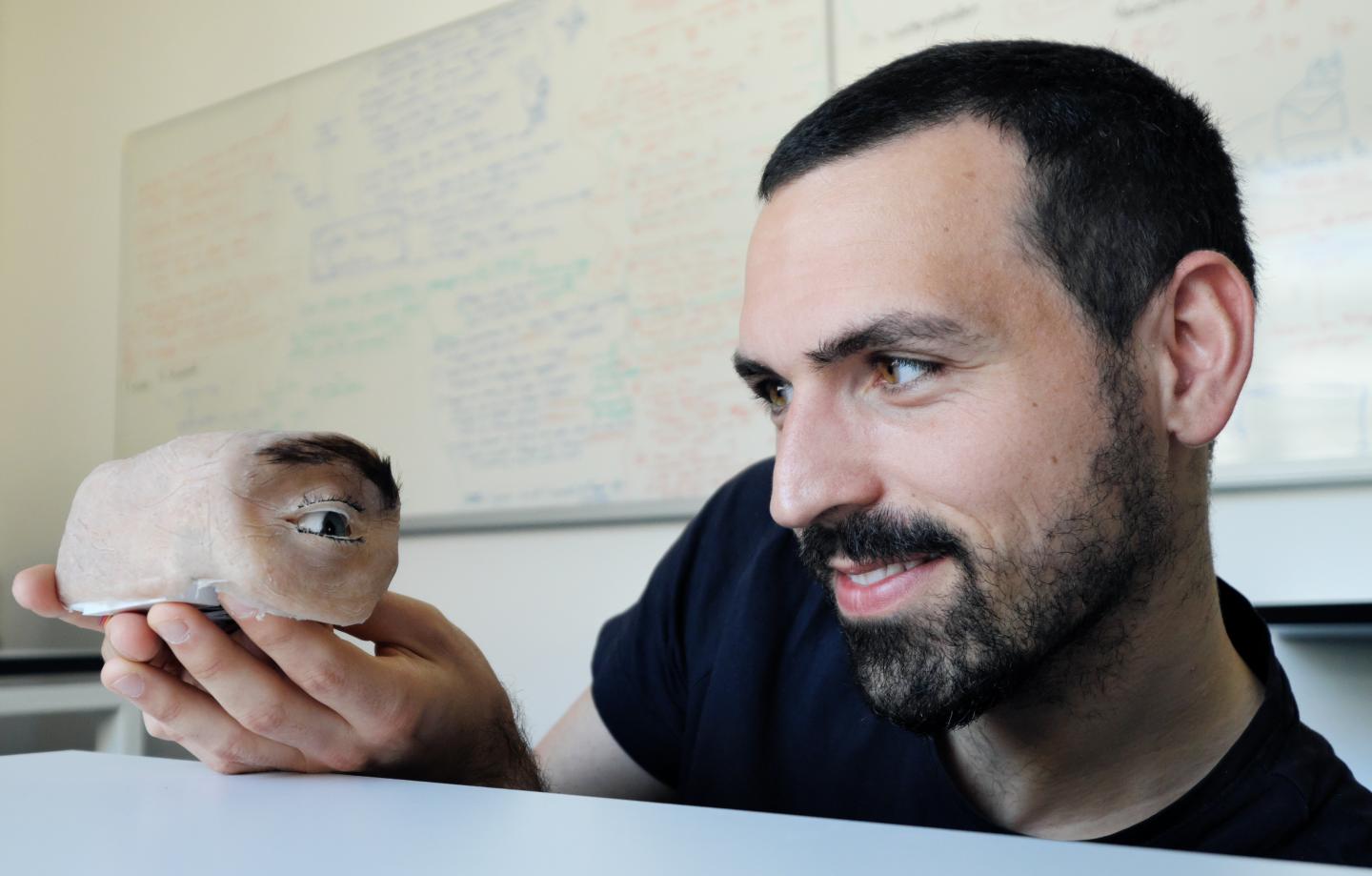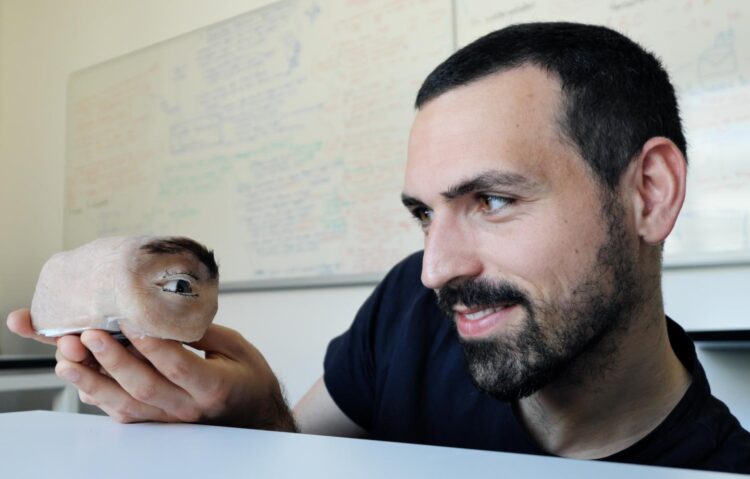
Credit: Thorsten Mohr
With ‘Eyecam’ they now present the prototype of a webcam that not only looks like a human eye, but imitates its movements realistically. “The goal of our project is not to develop a ‘better’ design for cameras, but to spark a discussion. We want to draw attention to the fact that we are surrounded by sensing devices every day. That raises the question of how that affects us,” says Marc Teyssier. In 2020, the French scientist completed his doctorate on the topic of anthropomorphic design in Paris. Now he is a postdoctoral researcher in the Human-Computer Interaction Lab at Saarland University in Germany.
The research team at Saarland Informatics Campus has developed a webcam that not only looks like a human eye, but also realistically imitates unconscious eye movements such as blinking or raising the eyebrow. “With ‘Eyecam’ we are exploring the question of whether a technical device should reflect its function in its design,” adds computer scientist Marion Koelle, who did her doctorate on the social acceptance of body-worn cameras. “There are different ways of seeing, all of which have their own unique connotations, such as observing, recognizing, watching, or even spying. Also, a camera designed as an eye can send nonverbal signals through facial expressions. This opens up a whole new layer of interaction that hasn’t existed in technical devices before,” Koelle adds.
“The research is part of a whole series of work within a large EU-funded project, the ERC Starting Grant ‘InteractiveSkin’. Here we are researching how interfaces that have properties of the human body can improve the interaction between humans and computers,” says lab director Professor Jürgen Steimle.
The researchers use the unique capabilities and optics of their new development to explore different facets of ubiquitous sensing. Already today, webcams are a potential privacy risk. ‘Eyecam’ exaggerates this aspect, acting as an observer by opening its eye and tracking the user with its gaze. Alternatively, the anthropomorphic camera could be used for self-reflection, with the artificial eye getting ever more tired and repeatedly falling shut as the user sits in front of the computer late at night. Or it could take on the role of a pet that is simply there, looking around from time to time and reacting with delight when its owner enters the room.
“Our application scenarios are fictional and are intended to encourage people to think about how we interact with technical devices today, but also in the future. What is special is that we can experience and recreate our imagined scenarios with the help of a physically existing prototype,” says Marc Teyssier. To reach as many people as possible with their thought-provoking development, the group has published the blueprints for their device.
###
Original Publication:
The original publication titled “Eyecam: Revealing Relations between Humans and Sensing Devices through an Anthropomorphic Webcam” was accepted by the world’s largest conference in the field of human-machine interaction. In May, it will be published at the 32nd “ACM Conference on Human Factors in Computing Systems (CHI)” in Yokohama (Japan). Besides Marc Teyssier and Marion Koelle, Paul Strohmeier, Bruno Fruchard and Professor Jürgen Steimle, all from Saarland University, were involved in the project.
A PDF preprint version of the paper can be found at: https:/
Further Information:
https:/
https:/
https:/
https:/
https:/
Questions can be directed at:
Prof. Dr. Jürgen Steimle
Email: [email protected]
Tel.: +49 681 302 71080
Dr. Marc Teyssier
Email: [email protected]
Tel.: +49 681 302 71084
Dr. Marion Koelle
Email: [email protected]
Tel.: +49 681 302 71931
Background Saarland Informatics Campus:
800 scientists and about 2100 students from more than 80 nations make the Saarland Informatics Campus (SIC) one of the leading locations for computer science in Germany and Europe. Five world-renowned research institutes, namely the German Research Center for Artificial Intelligence (DFKI), the Max Planck Institute for Computer Science, the Max Planck Institute for Software Systems, the Center for Bioinformatics and the Cluster for “Multimodal Computing and Interaction” as well as Saarland University with three departments and 24 degree programs cover the entire spectrum of computer science.
Editor:
Philipp Zapf-Schramm
Competence Center Computer Science
Saarland Informatics Campus
Phone: +49 681 302-70741
E-Mail: [email protected]
Public relations work at the Saarland Informatics Campus is supported by the Competence Center Computer Science Saarland, funded by the European Regional Development Fund (ERDF) and the Saarland State Chancellery.
Media Contact
Philipp Zapf-Schramm
[email protected]
Original Source
https:/





